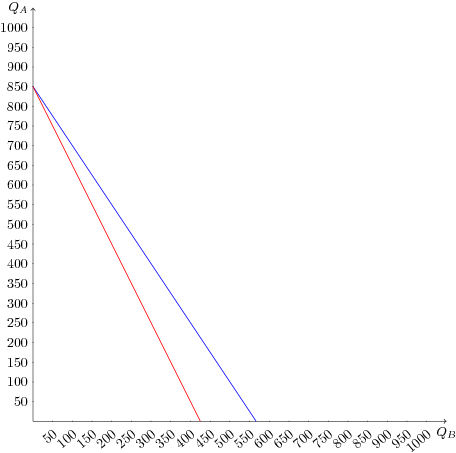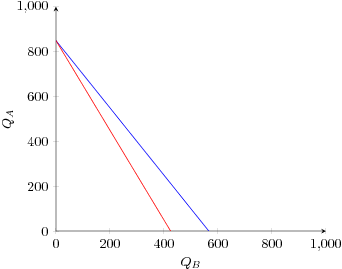|
Hallo, an der Achsenbeschriftung sollen statt 5, 10, 15,..., 100 die Werte 50, 100, ...., 1000 stehen. Wie skaliere ich das richtig? \begin{tikzpicture}[xscale=0.1,yscale=0.1,samples=4000] \draw[->] (0,0) -- (105.0,0) node[below] {$Q_B$}; \draw[->] (0,0) -- (0,105.0) node[left] {$Q_A$}; \foreach \i in {5.0,10.0,...,100.0} { \draw (\i,0.1) -- (\i,-0.1) node[below] {$\i$}; } \foreach \i in {5.0,10.0,...,100.0} { \draw (0.1,\i) -- (-0.1,\i) node[left] {$\i$}; } \draw[blue,domain=0:56.66] plot (\x,{85.0-1.5*\x}); \draw[red, domain=0:42.5] plot (\x,{85.0-2*\x}); \end{tikzpicture} |
|
Das scheint ja eine einfache Multiplikation mit 10 zu sein. Die führt man am besten mit \documentclass{article} \usepackage{tikz} \begin{document} \begin{tikzpicture}[xscale=0.1,yscale=0.1,samples=4000] \draw[->] (0,0) -- (105.0,0) node[below] {$Q_B$}; \draw[->] (0,0) -- (0,105.0) node[left] {$Q_A$}; \foreach \i in {5.0,10.0,...,100.0} { \pgfmathtruncatemacro{\ticlabel}{\i*10} \draw (\i,0.1) -- (\i,-0.1) node[below,anchor=north east,rotate=40] {$\ticlabel$}; } \foreach \i in {5.0,10.0,...,100.0} { \pgfmathtruncatemacro{\ticlabel}{\i*10} \draw (0.1,\i) -- (-0.1,\i) node[left] {$\ticlabel$}; } \draw[blue,domain=0:56.66] plot (\x,{85.0-1.5*\x}); \draw[red, domain=0:42.5] plot (\x,{85.0-2*\x}); \end{tikzpicture} \end{document}
Vielleicht möchtest du auch lieber \documentclass{article} \usepackage{pgfplots} \pgfplotsset{compat=newest} \begin{document} \begin{tikzpicture} \begin{axis}[ xlabel=$Q_B$, ylabel=$Q_A$, axis lines=left, domain=0:1000, xmin=0,xmax=1000, ymin=0,ymax=1000, no markers, ] \addplot {10*(85.0-1.5*x/10)}; \addplot {10*(85.0-2.0*x/10)}; \end{axis} \end{tikzpicture} \end{document}
(25 Mai '17, 09:45)
saputello
Vielen Dank Henri, das hat mir sehr weiter geholfen!
(25 Mai '17, 13:04)
kongooddo
|


